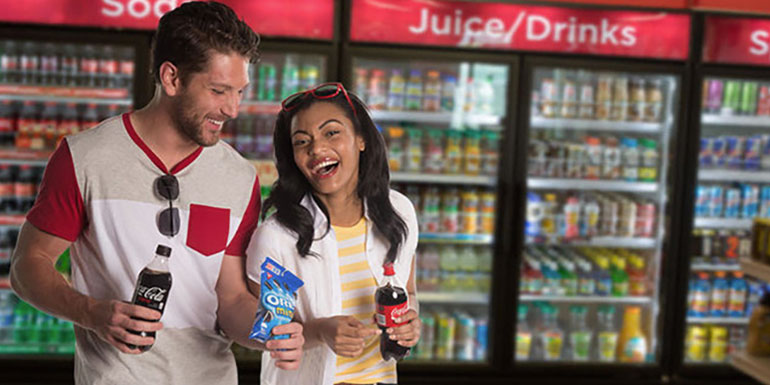
Value in the Cold Vault
Tap into your convenience store's revenue goldmine

If nearly 60% of all c-store shoppers make a beverage purchase, then the cold vault is a gold mine for increasing revenue. A steady driver of traffic and overall store sales, this destination is worth any strategic or monetary investment that makes it sparkle.
According to iSHOP 2014, 25% of shoppers who made an in-store purchase also said they came to that store specifically for a beverage—higher than any other in-store category.
“When people visit the cold vault in a c-store, they engage with and purchase other products throughout the store,” says Clint McKinney, group director category advisory and space strategy at The Coca-Cola Company, Atlanta, Ga. “Considering the margins and ROI that immediate consumption, nonalcoholic packaged beverages deliver, the cold vault should be a vital part of any c-store’s marketing strategy.”
In fact, Coca-Cola field reps work with retail customers to help them find their cold vault sweet spot—the right assortment for their demographics and location to maximize category sales and store profits.
“It’s so important they know what gets their consumers inside their store, how their cold vault helps sell other products like snacks, and how sparkling beverages can help drive traffic,” McKinney says.
The Need to Get It Right
With 1,400 new immediate consumption, nonalcoholic beverages introduced in the United States each year, striking that sweet spot can be a challenge. The number of SKUs stocked in the cold vault has grown over 12% in the last four years, and is currently at 297 SKUs, according to Nielsen’s 2014 Custom Store Audit, Total U.S. Convenience Store Channel.
“We tell our retailers not to get caught up in the next new item,” McKinney advises. “While new intros account for $475 million a year of immediate consumption sales, only 38 of those 1,400 SKUs drove 80% of the innovation dollars in the cold vault last year. The key is to get the right assortment for your store.”
To ease the burden, Coca-Cola field reps surveyed independent operators across the country to discover their stores’ primary shoppers, busiest time of day, meal solutions offered and most popular items. The data collection resulted in a detailed shopper segmentation analysis of the purchasing behavior of a store’s target consumer based on ethnicity, income and age.
“We then allocated space in the cold vault based on the shopper analysis,” McKinney says. “A store with mostly teen and adult shoppers may want to feature more of the value-added dairy, coconut water and newer teas, for example, whereas a store frequented by blue-collar males may have more traditional products like water, soft drinks and sports drinks.”
National chains also benefit from The Company’s analytical services. To simplify the process for large chains with hundreds of stores, the beverage manufacturer works with operators to narrow down the assessment to three or four segments based on the retailer’s goals.
Work with What You Have
Surprisingly, this proliferation of new products has not affected the size of the cold vault, which featured 7.8 doors on average in 2010 and eight doors in 2014 (Nielsen Custom Store Audit, Total U.S. Convenience Store Channel, March 2010, September 2014).
“The number of SKUs has grown more than 12% in the last four years,” McKinney says. “With 393 facings in a cold vault, each SKU averages about 1.3 facings. That means nearly every single item in the cold vault is single-faced—alarming, considering the number of beverages we are trying to cram into the case.”
While some larger chains are able to expand the cold vault when they renovate or build new stores, others rely on additional structures throughout the store to hold overflow. These units are especially helpful when promoting “future consumption” beverages, such as six-packs or two-liter bottles, an area of growth potential for c-stores.
“Regardless of how sophisticated your systems are, you need to look at all the SKUs you carry, which ones are delivering the most return on investment, and which ones have the highest rate of turns whether on a semi-annual, annual or even quarterly basis,” McKinney says.
Sparkling Thrives
Perceived slight declines in sparkling beverages have led to rumors of the category’s waning, but nothing could be further from the truth, according to McKinney. “The sparkling category is full of innovation and differentiation,” he says. “Any talk about this segment shrinking is a misnomer.”
Again, future consumption sizes of sparkling beverages hold great growth potential for c-stores. In the past, consumers have tended to buy these products at supermarkets and drug stores. For c-stores interested in selling more future consumption beverages, stand-alone displays are a practical option in light of cold vault overflow.
“We urge retailers to take their cold vaults seriously...to make sure the assortment is right to maximize sales for their store,” McKinney concludes. “Consider your primary shoppers’ needs, and give them what they want while creatively guiding them to other products in the store. Trust me, it’s worth the attention and investment you put into it.”